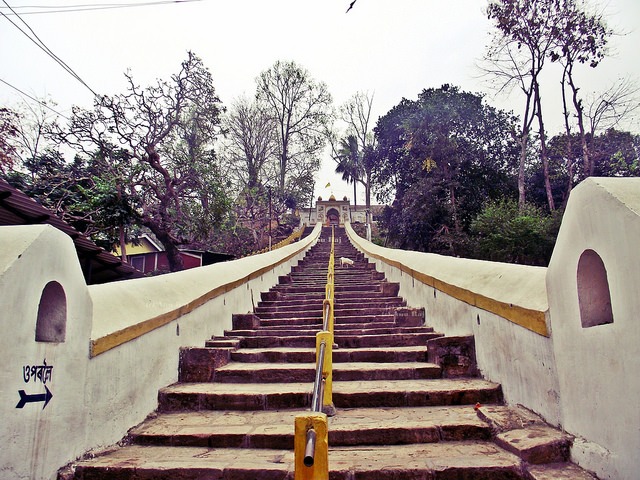Anuradha Manjul is an avid traveler and narrates her experience of this unique Temple in Hajo Assam:
While we were planning our trip to Guwahati we had very limited information on options available for sightseeing. Numerous websites and even tour/travel planners talked about using Guwahati as a stopover for visiting Kaziranga, Imphal, Cherrapunji, Pobitara etc. or using Guwahati for religious pilgrimage (visiting numerous temples across the city). Beyond these two options no one was giving any other detailed options.
Just on the night of our departure, we watched an interesting episode of Ekkant on Epic where in they talked about an interesting locale in Assam which had a lot of historical destinations. Somehow in midst of all our flight schedules/stop overs and layovers, we completely forgot about the name of the locale. While in Delhi for our layover, did some random search on the internet and landed with a name of a locale, Hajo, a city which is around 35 kms away from Guwahati. Assuming that this would be the same locale we had seen, we marked it as a must visit locale in our itinerary.
When we checked in at our hotel in Guwahati, we checked out about this locale and were informed that this place can be easily visited by car (they suggested we could take the package tour which would show us Hajo and a few other locations in Guwahati, all mainly temples). We were confused as how could we complete sightseeing of Hajo in the way they were suggesting, but they didn’t provide us with any details. So it was back to the internet, places that we could visit in Hajo, its importance and so on. It was then we realised that the place we were looking for was a different place; we were actually thinking of Sivasagar which was around 382 kms away from Guwahati, close to Jorhat. Still we decided to check out Hajo. And trust me, we didn’t regret it.
Location :
Hajo, District Kamrup, Assam. This place is around 30 kms from Guwahati.
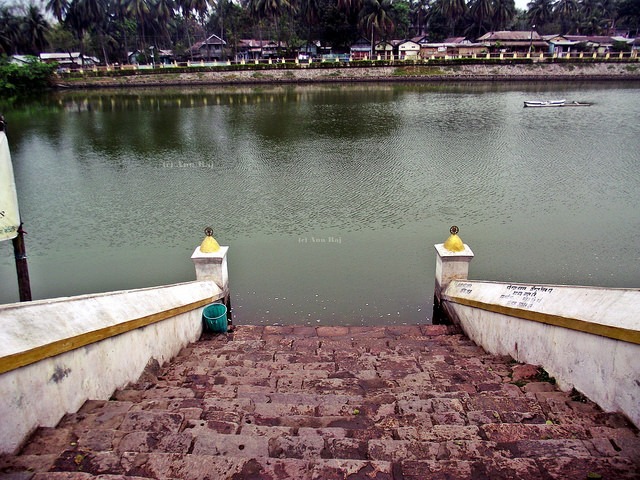
How to reach :
Taxis/Tourist Cabs are easily available from Guwahati which would take one to Hajo.
One can use State Transport Buses too.
We took a radio taxi (which you can hire for half day/full day) for our trip to Hajo and not the package tour option as was suggested. The route is really scenic (via NH 27 and NH 47). We crossed the Brahamputra via the famous Saraighat Bridge (It is the first rail cum road bridge constructed over the Brahamputra River in Guwahati it was opened to traffic in 1962 and has recently completed 50 years.) The bridge is heavily guarded and I can understand the reason (This bridge is of great importance as it serves as a vital link between North East and rest of India).
Since we were doing a video shoot (in the moving vehicle) of the trip and were asked by the Army personnel to stop shooting while crossing the bridge. (The taxi driver who probably would have been travelling multiple times via this bridge had not bothered to inform that shooting on the bridge was prohibited). A new bridge is being constructed right next to the Saraighat bridge; this bridge in all probabilities would open in Summers of 2017 and would help in easing out the pressure on the Saraighat bridge.
Sarai (thus the bank is named Saraighat) was a small village where old abandoned station of Amingaon was located. The famous battle of Saraighat between the Mughals (lead by Raja Ramsingh 1) and Ahoms (led by Lachit Borphukan) was fought near this place in the river during the reign of Aurangzeb. Ahoms though lesser in number defeated the Mughal army.
Best time to visit:
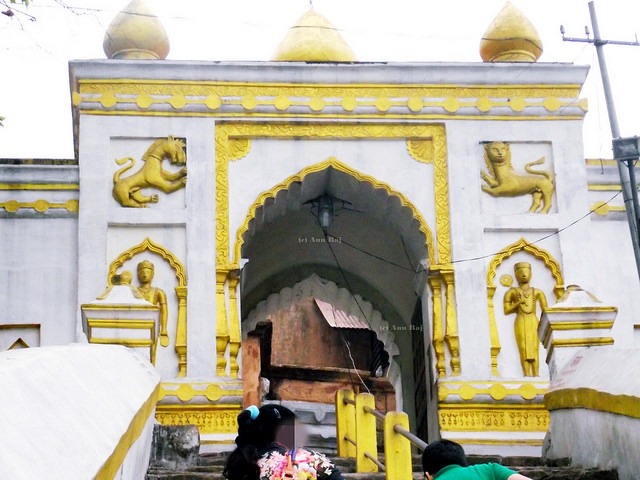
This place can be visited in any season from Sunrise to Sunset.
Monsoon or rainy seasons might be slightly tricky.
The weather was nice. It had rained in the morning and was still cloudy when we reached Hajo (District Kamrup). The city is more like a small village with mixed community. We could see and identify the Muslim and Non Muslim quarters, due to the structures of houses and the external upkeep and decor. Hajo is an ancient place, of immense historical and religious importance finding mention in different texts. Hajo is perhaps the only place in the state of Assam where one can find ancient temples dedicated to Lord Shiva, Vishnu, Ganesha and Goddess Durga along with an important Muslim shrines and Buddhists Gompa/temple. Hajo is thus considered sacred by people of all the three religions – Hindus, Muslims and Buddhists.
Hajo has been given different names in different eras and texts – in Kalika Purana it is described as Apurnabhava and Manikuta, in Yoginitantra it is called Bishnupuskar, in an 18th century text Darang Rangbonshabali it has been referred as Manikutgram. It has been an important seat of rule of the Kochs, the Mughals and the Ahoms; the Mughals described Hajo as Sujabad or Sujanagar. Its during the Ahom period when one find abundant mention of Hajo as ‘Hajo’, the present name.
It was the capital of the Koch dynasty- Raghudev, son of the legendary Koch hero Chilarai and the nephew of King Naranaryana of Kochbehar has established a separate Koch kingdom with Hajo as its capital in 16th century (the kingdom was known as Koch Hajo kingdom) .
Koch Hajo kingdom was under continuous occupation of the Mughals from 1639-1658. Rest of the times it alternated between the hands of Koch, Mughals and Ahoms.
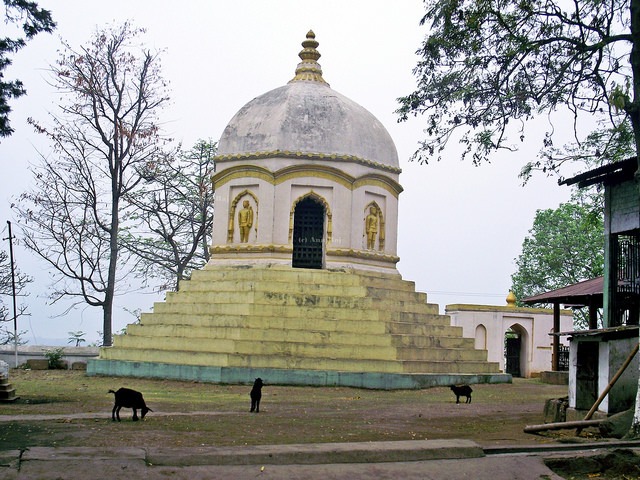
From the point of view of visiting, Hajo has many places to visit. It is advisable to hire a trained guide from Guwahati. The locals in Hajo are not very helpful in terms of giving information probably because of cultural and linguistic barriers. The tourism department has also not focused on providing information or directions.
We visited three places in Hajo- Hayagrib Madhab temple, Bhim Charali and Ganesh Temple.
Hayagrib Madhab temple is one of the oldest temple of the country. The temple is situated on a small hillock Monikuta or Manikuta. The temple is dedicated to Lord Vishnu (Hayagriba-Vishnu with horse head, one of the incarnations of Lord Vishnu). The story is that a demon stole the Vedas from Lord Brahma. Lord Brahma asked Lord Vishnu for help, who assumed the form of Hayagriba, killed the demon and recovered the Vedas. (This is recorded in Santiparva section of Mahabharat).
According to Matsya Purana the Hayagriba incarnation of Lord Vishnu preceded the Matsya incarnation, according to this after ‘Pralay’ (end of the world) Lord Vishnu in the form of Hayagriba (one with horse head) recompiled the Vedas, Vedangs etc. According to Kalika purana Lord Vishnu in the form of Hayagriba killed Jvarasura (Fever Demon) at Manikuta hills, and lived here for the benefit of mortals and immortals. Lord Vishnu took a recovery bath here to get rid of the effects of Jvarasura. This place thus gets referred as Apunarbhava – whosoever comes/bathes here suffers no second birth.
The Devi Purana and the Skanda Purana though give two different accounts on the origin of Hayagriba; one of them is popular in Northern India, Hayagriba is the demon who steals the Vedas, he is killed by Lord Vishnu.
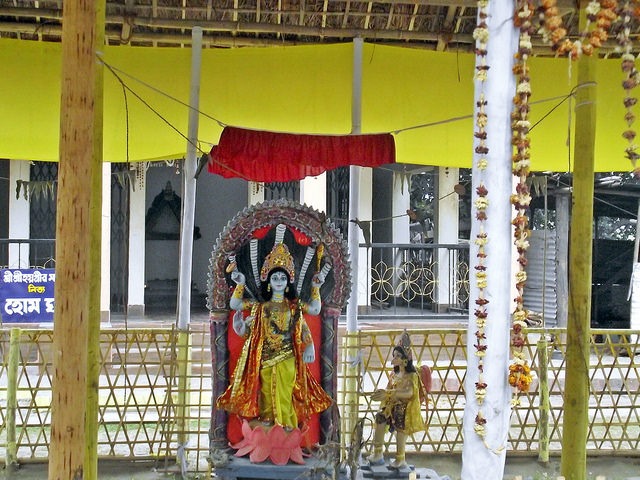
It is said that the original temple was constructed by a King of Pala dynasty. The temple was demolished by Kalapahar and the present temple structure was constructed by King Raghudev Narayan the founder of the Koch Hajo dynasty.
The Yoginitantra gives an account of the origin of the images of Vishnu in Manikuta (i.e. the Hyagriba Madhab Temple). King Indrayumna of Orissa in his dream was told that a big tree would come floating by the sea shore, he was to take an axe and cut the same in 7 pieces. The dream turned true, the next morning he saw the tree and did exactly as he was told. Out of the seven pieces two pieces were brought to Hajo, with one piece the image of Hayagriba was made and with the image of Madhab (this one looks like an exact replica of the image in Jagannath Puri).
The road sign directed us to this temple (located slightly in the interior, away from the main highway). We could park our vehicle conveniently (there was no proper designated parking, probably proper arrangements are done during the festivals of Doul (Holi) and Janmasthami etc.). There was lady selling flowers and other items for the puja and was also managing the shoe deposit area. We could not see many people here. The place was really really peaceful. Just in the beginning there is a big pond called Madhab Pukhuri (Pukhuri in Assamese means a pond). It is said that there is a tortoise who has been living here for hundreds of years (a link with the Kurma Avatar/incarnation of Lord Vishnu). Visitors can feed this tortoise, locals sell the rice puffs for feeding the tortoise. We did saw the friendly tortoise (but we cannot tell how old it was).
To reach the main temple complex, one has to climb a stairway (this is divided in two parts with a railing separation – one can be used for going, the other for coming down) with decent number of stairs (We didn’t count them, but could have been anything close to 80-100). While climbing the stairway we got a beautiful view of the places close by. There was a goat who decided to give us company during our climb and kept on jumping from one stair to the other, finally sitting royally on one of the stairs – we had to jump on the other side to complete our climb.
Once atop, we entered a peaceful area. We could only hear the birds (parrots, pigeons, doves) and see numerous goats frolicking around. The main temple is a stone structure where beautiful carvings and sculptures of stories of Lord Vishnu and his incarnations can be seen. The entrance is made of four blocks of granite which opens into an anteroom made of stone. Two stone screens in the form of lotus flowers lay on either side of the room having openings for light and air. Stone steps lead us to the Garbhgriha which contains the image of the residing deity. This area is quite dark but compared to the Garbhgriha in Kamakhya this place has enough visibility.
An old priest inside tried his best to explain the importance of the temple and various legends associated with the temple in broken Hindi and Bangla, fluent Assamese. We could gather the crux of whatever he was trying to explain. (We don’t speak Assamese or Bangla, but thankfully can understand a bit of Bangla, all thanks to some Bangla friends) Please don’t expect him to speak in English or for that matter proper Hindi. (It is advisable to use the services of professional guides who can translate and explain). The warmth in his behaviour and his not being greedy really made this temple trip truly spiritual. The old priest was the chief priest and is called Dalai. He is elected from among the local priests and holds office till his death.
The calm and serene environment makes up for everything else. One can sit in the complex for hours and get away from the mad mad world. The view of the valley below (from the rear side) is beautiful.
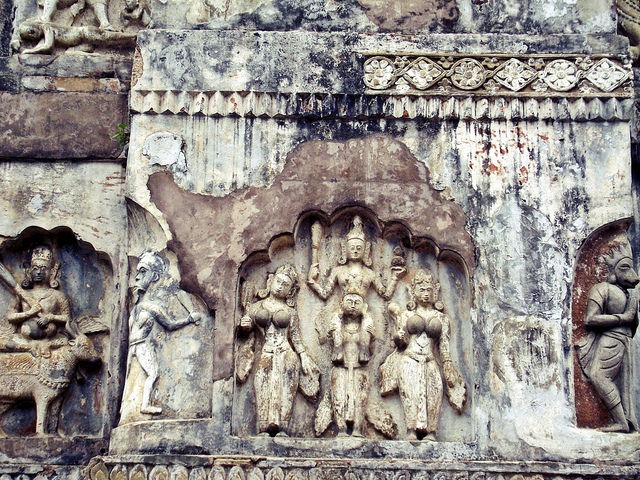
The Shikhara of the temple has pyramid like structure, the entire structure resting atop enormous brick pillars.
Other than the Vaishvanites or the worshippers of Vishnu, this temple has great importance for Buddhists also. Buddhists of the region believe that it was here that Buddha (as per the temple 9th incarnation of Lord Vishnu) attained Parinirvana. They also believe that death of Buddha pained his disciples a lot who in their painful ecstasy uttered “Ha-ju” meaning the setting of the sun, thus giving this place the name Hajo. Some say that the relics of Buddha (Mahamuni Buddha) are stored here. A large number of Buddhists from neighbouring Bhutan are said to visit this place. (We didn’t see anyone, nor was there any indication of how Buddhism is practiced here).
There is a structure in the temple complex which looks like a Buddhist Gompa. Nothing was mentioned and the goats were really enjoying the green grass around this area.
Just close to the main temple is the place where Doul is celebrated.
We ended our trip to this serene destination, spiritually enlightened and carrying with us a load of memories, ready to explore Bhim Chairali.
Do connect with us on: https://amanjul.wordpress.com/
About the Author
A Management Graduate with 20+ years of experience in Marketing, Public Relations & Corporate Communication.
Travel to me is a part of my life. I am not a nomad, I am not a gypsy but I feel that to know more about your country and its people, one should travel I am an avid traveller and thankfully my spouse and kid share the same passion. We love to visit different places try to explore more from the usual and that too in a fixed budget. And yes not to forget, I like to add a dash of history and various legends about the place, wherever required.
I believe India has a lot of potential in terms of tourism and travel. One life would not be enough to completely cover India, travel across the entire length and breadth of the country. And I am not talking about Leisure travel – the real fun is in the mid range and budget travel.
Thanks to my parents, since childhood I have been travelling to various destinations in India. My quest to know more and more about the country has still not ended and I hope it never ends.
I am a senior contributor on TripAdvisor and Holiday IQ.
